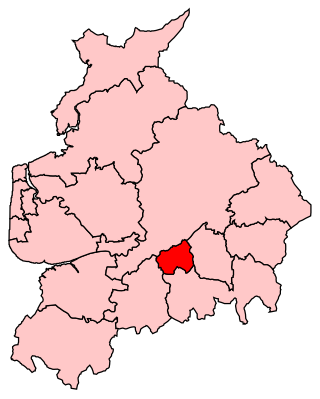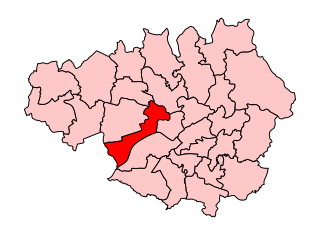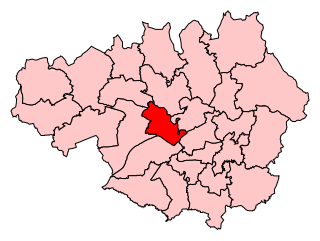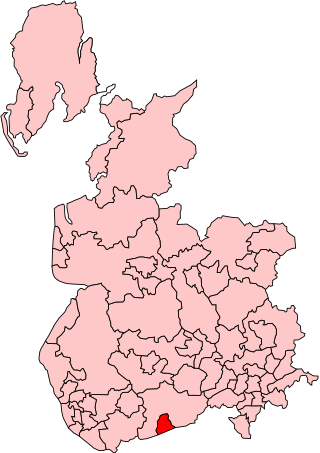Boundaries
Boundaries 1832–1885
In 1832 the constituency was formed from the townships of Broughton, Pendleton and Salford, with part of the township of Pendlebury. The exact boundaries were defined in the Parliamentary Boundaries Act 1832: [3]
From the Northernmost Point at which the Boundary of the Township of Salford meets the Boundary of the Township of Broughton, Northward, along the Boundary of the Township of Broughton, to the Point at which the same meets the Boundary of the Township of Pendleton; thence, Westward, along the Boundary of the Township of Pendleton to the Point at which the same meets the Boundary of the detached Portion of the Township of Pendlebury; thence, Southward, along the Boundary of the detached Portion of the Township of Pendlebury to the Point at which the same meets the Boundary of the Township of Salford; thence, Westward, along the Boundary of the Township of Salford to the Point first described.
In 1883 the detached portion of Pendlebury was absorbed by Pendleton. [1]
Boundaries 1997–2010
The constituency was re-created for the 1997 election. It boundaries were defined by the Parliamentary Constituencies (England) Order 1995, and consisted of eight wards of the City of Salford: Blackfriars, Broughton, Claremont, Kersal, Langworthy, Ordsall, Pendleton, and Weaste & Seedley. [4]
A very safe Labour seat which had some of the UK's most deprived areas, typified by council estates like Ordsall, Pendleton and Langworthy, which are now due for apparent redevelopment. Higher Broughton has a considerable Jewish population and has some very decent residential housing, but even here Labour are usually in the lead at local level; the Conservatives, like all the other neighbouring Manchester seats, are now in third place in General Elections.
Proposed
Further to the 2023 Periodic Review of Westminster constituencies, enacted by the Parliamentary Constituencies Order 2023, from the next general election, due by January 2025, the re-established constituency will be composed of the following wards of the City of Salford (as they existed on 1 December 2020):
- Blackfriars & Trinity; Broughton; Claremont; Ordsall; Pendlebury & Clifton; Pendleton & Charlestown; Quays; Swinton Park; Weaste & Seedley. [5]
The constituency will comprise the majority of, and replace, the constituency of Salford and Eccles - excluding the towns of Eccles and Swinton. It will also include Broughton, transferred from Blackley and Broughton (to be abolished).

Salford is a city in Greater Manchester, England. The city is situated in a meander on the western bank of the River Irwell which forms its boundary with Manchester and its city centre. Landmarks in the city include the old town hall, cathedral and St Philips Church. It is the main settlement of the wider City of Salford metropolitan borough.

Salford, also known as the City of Salford, is a metropolitan borough with city status in Greater Manchester, England. The borough is named after its main settlement, Salford, but covers a larger area which includes the towns of Eccles, Swinton, Walkden and Pendlebury. The borough had a population of 270,764 in 2021, and is administered from the Salford Civic Centre in Swinton.

Blackburn is a constituency in Lancashire, England, which has been represented in the House of Commons of the UK Parliament since 2015 by Kate Hollern of the Labour Party. From 1979 to 2015, it was represented by Jack Straw who served under the Labour leaders of Neil Kinnock and John Smith and the Labour governments of Tony Blair and Gordon Brown.

Eccles was a parliamentary constituency of the United Kingdom, centred on the town of Eccles in Greater Manchester, England. It returned one Member of Parliament (MP) to the House of Commons of the Parliament of the United Kingdom, elected by the first past the post system.

Manchester, Blackley was a borough constituency represented in the House of Commons of the Parliament of the United Kingdom which existed from 1918 to 2010. It elected one Member of Parliament (MP) by the first past the post system of election. In boundary changes for the 2010 general election it was replaced by Blackley and Broughton.
Armagh was an Irish constituency in the House of Commons of the United Kingdom from 1801 to 1885.

Blackley and Broughton is a constituency represented in the House of Commons of the UK Parliament by Graham Stringer. He was first elected in 1997 for the former Manchester Blackley and prior to this was Leader of Manchester City Council. The constituency covers north Manchester and east Salford.

Salford and Eccles is a constituency represented in the House of Commons of the UK Parliament since 2015 by Rebecca Long-Bailey, a member of the Labour Party.

Salford was, from 1844 to 1974, a local government district in the county of Lancashire in the northwest of England, covering the city of Salford. It was granted city status in 1926.
Seedley is an inner city suburb of Salford, Greater Manchester, England.

Warrington was a parliamentary constituency in the United Kingdom. From 1832 to 1983 it returned one Member of Parliament (MP) to the House of Commons of the Parliament of the United Kingdom.
Salford East was a parliamentary constituency in the City of Salford in Greater Manchester. It returned one Member of Parliament (MP) to the House of Commons of the Parliament of the United Kingdom.
Merthyr Tydfil was a parliamentary constituency centred on the town of Merthyr Tydfil in Glamorgan. From 1832 to 1868 it returned one Member of Parliament (MP) to the House of Commons of the Parliament of the United Kingdom, and in 1868 this was increased to two members. The two-member constituency was abolished for the 1918 general election.

North Lancashire was a county constituency of the House of Commons of the Parliament of the United Kingdom. It was represented by two Members of Parliament. The constituency was created by the Great Reform Act of 1832 by the splitting of Lancashire constituency into Northern and Southern divisions.
South East Lancashire was a county constituency of the House of Commons of the Parliament of the United Kingdom. It was represented by two Members of Parliament. The constituency was created by the Reform Act of 1867 by the splitting of the South Lancashire constituency into South-West and South-East divisions.
North East Lancashire was a county constituency of the House of Commons of the Parliament of the United Kingdom. The constituency was created by the Reform Act of 1867 and replaced the North Lancashire Parliamentary constituency, a county division with two seats.
The Salford Advertiser is a weekly newspaper serving the villages, suburbs and districts of the City of Salford in Greater Manchester, England.
This page is based on this
Wikipedia article Text is available under the
CC BY-SA 4.0 license; additional terms may apply.
Images, videos and audio are available under their respective licenses.











